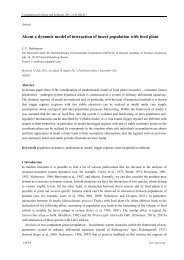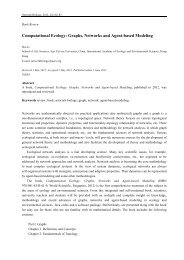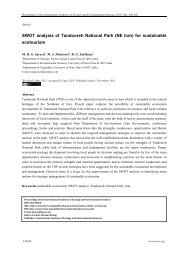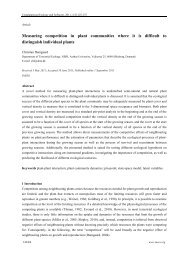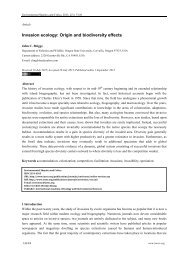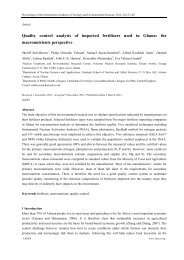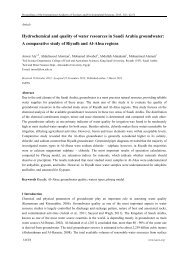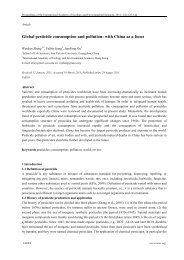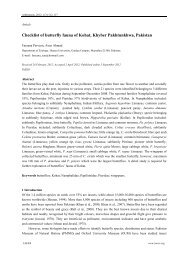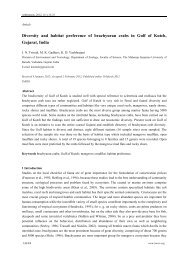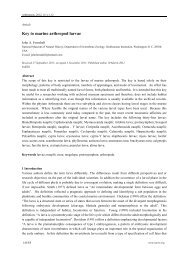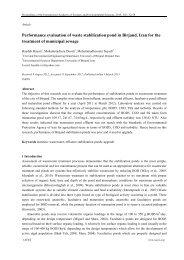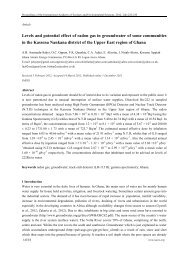Synthetic Aperture Radar (SAR) images features clustering using ...
Synthetic Aperture Radar (SAR) images features clustering using ...
Synthetic Aperture Radar (SAR) images features clustering using ...
You also want an ePaper? Increase the reach of your titles
YUMPU automatically turns print PDFs into web optimized ePapers that Google loves.
Computational Ecology and Software, 2012, 2(4):220-225<br />
221<br />
target. The length of the track of the radar that covers the target area determines the resolution of image and is<br />
referred as azimuth. The longer the antenna size the better is the resolution.<br />
As the radar moves relative to the ground, the received pulses are Doppler shifted: positively as it move<br />
away and negatively as it approaches towards the target. These Doppler shifted frequencies should be well<br />
addressed in order to precisely sense the remote object. A number of algorithms have been proposed to address<br />
this issue.<br />
The polarized nature of <strong>Radar</strong> waves make it possible to detect surface changes of certain material<br />
including vegetation or soil moisture. <strong>Radar</strong> antenna receiver and transmitter involve three different<br />
configurations of polarizations which are HH-pol, VV-pol and VH-pols. These configurations are used to<br />
represent three colors in synthesis image. Number of studies has been performed <strong>using</strong> polarization technique,<br />
including (Hashim et al., 1999) for rain forest mapping. (Barotani et al., 1995) presents <strong>SAR</strong> Polarmetric<br />
<strong>features</strong> for agricultural monitoring.<br />
Chirp or pulse compressed signal is widely used in <strong>SAR</strong> systems. The pulse width in chirp radar is much<br />
longer due to which it emits more energy but usually hinder range resolution. Longer pulse width also results<br />
in frequency shift, so the chirped short signal is correlated with the transmitted pulse on its reception. Moreira<br />
and Huang (1994) used Chirp scaling algorithm for high resolution processing of <strong>SAR</strong> data with high squint<br />
angle and motion error.<br />
In this paper we will discuss the application of FCM Algorithm for <strong>SAR</strong> System applications for remote<br />
sensing. A brief description of specialized <strong>SAR</strong> technique termed as Differential <strong>Radar</strong> Interferometry<br />
(DIn<strong>SAR</strong>) is presented in section 2. In section 3, FCM Algorithm applied on <strong>SAR</strong> Image. The paper is<br />
concluded in Section V with future research directions.<br />
2 <strong>SAR</strong> Interferometry<br />
2.1 Defination<br />
<strong>Synthetic</strong> <strong>Aperture</strong> <strong>Radar</strong> (<strong>SAR</strong>) systems record both amplitude and phase of the backscattered echoes. The<br />
phase of the backscattered echoes represents each pixel of the image and is comprised of the following three<br />
components (Rocca and Prati, 2012):<br />
1) Two way travel path from radar antenna to target and from target back to radar antenna.<br />
2) Interaction between the incident and scattered electromagnetic waves.<br />
3) The phase shift induced by the processing system used to focus the image.<br />
Single <strong>SAR</strong> image phase has no practical value. Two <strong>SAR</strong> <strong>images</strong> taken from slightly different angles are<br />
termed as Interferometric pair and their phase difference is termed as Interferometric fringes. The phases of<br />
Interferometric pair can be used to develop Digital Elevation Maps (DEM’s).<br />
2.2 Limitations of DIn<strong>SAR</strong><br />
DIn<strong>SAR</strong> has some limitations which adversely affects the accuracy of the system. One such limitation is due to<br />
the fact that satellite platform do not follows an ideal trajectory. This inaccuracy should be well addressed to<br />
maintain the reliability of the system, and it is termed as Motion Compensation (MoCo).<br />
Another form of inaccuracy is termed as Residual Motion Error (RME’s). This type of inaccuracy is the<br />
result of measurement error due to antenna position, which is in the order of 1-5 cm. In order to address<br />
Motion Compensation and Residual Motion Error in topological variation, number of algorithms has been used.<br />
Some examples are Frequency Division algorithm, Topography and <strong>Aperture</strong> Dependant (TAD) algorithm,<br />
Sub Topography <strong>Aperture</strong> Dependant (SATA) algorithm (de Macedo and Scheiber, 2005).<br />
2.3 <strong>SAR</strong> processing scaling algorithms<br />
IAEES<br />
www.iaees.org



